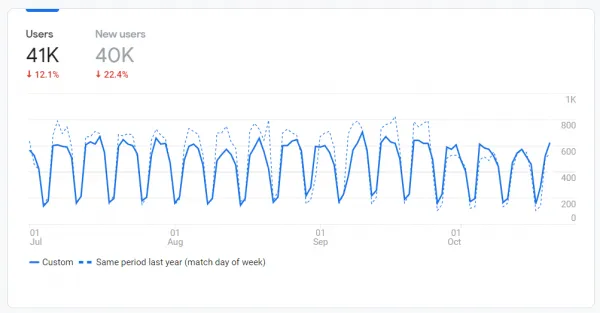4 Reasons Why You Should Upgrade to Google Analytics 4

Whenever a new version of any product is released, it’s logical to ask yourself whether it’s worth upgrading. Do you really need that new phone, that latest gaming console, or the most recent model of your car? What will it give you that you don’t currently have? In some cases you may decide to wait for the next iteration, but sometimes the benefits of the new version make upgrading a no-brainer.
Google Analytics 4 (GA4) is arguably the biggest update in the 15-year history of the tool. This new version of Google Analytics is the result of years of development and will continue to be enhanced in the months and years ahead. It represents the future of analytics, and the sooner you jump on board the better.
Although it will require time and effort to upgrade your implementation, the long-term benefits will far outweigh the short-term costs. In this article, we outline four key reasons to upgrade to GA4. It’s an investment for your future, an opportunity to realign your analytics with business objectives, a way to enhance your tracking and measurement, and a vehicle for more efficient and powerful analysis.
So, what are you waiting for? Read on and get started with GA4 today!
1. Invest for your future
GA4 is clearly the future of Google Analytics. All of Google’s present and future development efforts in Analytics will be put towards GA4. So, the earlier you get started with GA4, the earlier you can realize the benefits. While there are no plans to deprecate Universal Analytics (UA), it will likely be maintained in its current state without any added features or improvements. In the ever-changing landscape of digital marketing and analytics, UA will inevitably become less and less relevant.
So, what should you do? Any digital analyst would know that you cannot go back in time to collect data. If you haven’t configured data collection from the beginning of a campaign or the launch of a website, you can’t retroactively do it later. As exciting and powerful as GA4’s new capabilities are, time travel isn’t one of them.
GA4 is an entirely separate type of property with a different data structure from UA. None of your historical data will carry over. So, you won’t be able to immediately start using GA4 for reports and analysis. You’ll need to allow time for data to collect. If you wish to see a year-over-year comparison for example, you will need to collect data for at least a year.
The best approach is to run GA4 in parallel with your existing UA implementation. You should continue to use UA as your “source of truth” until you have collected sufficient historical data in GA4 to support your analysis needs. You may also need to wait for specific UA features that you’re currently using to be rolled out in GA4, for example data import, calculated metrics, or custom channel grouping. Although GA4 is out of beta, the Google team is still actively working to enable feature parity with UA.
2. Refresh and realign your analytics
Is your current GA implementation fulfilling your needs? Can you measure all your digital marketing KPIs? Do you even have KPIs that align with your organization’s objectives? The arrival of GA4 presents the perfect opportunity to audit the current state of your analytics and ensure it aligns with your objectives and strategy. If your implementation in UA is already inadequate, simply migrating it to GA4 without addressing the deficiencies would be a waste. Garbage in, garbage out.
GA4 requires you to see your website activity and visitors through a different lens. Instead of pageviews and events, you will track every interaction as an event with associated parameters. Instead of goals, you will configure conversions. Instead of views, you will setup data streams. So, regardless the state of your current GA implementation, you will need to re-think and re-design how you capture the interactions, metrics, and segments you need in order to measure and optimize your website, app, or digital marketing initiatives.
Before embarking on a GA4 implementation project, it would be wise to create or update your analytics measurement plan to guide your design decisions. Your measurement plan should outline your business objectives, the digital tactics that you execute to fulfill those objectives, KPIs that evaluate the success of each tactic, and segments that identify key audience groups. This will provide the best framework for deciding how to structure the events, parameters, conversions, and other components of your GA4 implementation design.
3. Enhance your tracking and measurement
One of the most exciting new features in GA4 is called “enhanced measurement,” which automatically tracks file downloads, outbound clicks, video interactions, site search, and scroll events via the base GA4 tag. You can simply turn on enhanced measurement from the GA4 interface; No additional code or tagging is required. As a result, GA4 raises the out-of-the-box functionality of Google Analytics and reduces the amount of custom tagging for you to maintain.
GA4 also takes engagement tracking to the next level. Gone is the infamous Bounce Rate, replaced by more sophisticated measures of Engaged Sessions and Engagement Time. A visitor is automatically labelled as “engaged” if they spend longer than 10 seconds on the site, view 2 or more pages/screens, or complete a conversion event. Engagement time is only counted while the webpage or app is in the foreground. Although it may take some getting used to for long-time GA users, GA4 provides a more useful standard measure of engagement.
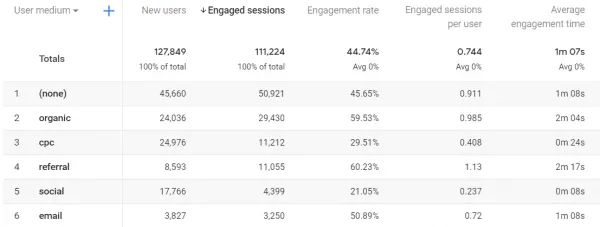
Finally, GA4 enables you to identify visitors across devices more accurately by leveraging Google’s user identity data. Unless visitors are always logged-in to your website or app, it has long been a challenge to identify the same person across multiple devices. GA4 can use data from Google Signals to stitch together users across devices, even when they don’t have a user ID. GA4 will by default employ the most accurate method to identify each user, first looking for a user ID, then data from Google Signals if activated, and failing the first two options will use the default Client ID.
4. Find more insights, more quickly
GA4 aims to become an analyst’s best friend by offering more efficient and powerful methods of analysis. The aptly-named “Analysis Hub” is the centre of custom reporting and analysis in GA4 and will likely become its most popular feature for power users. Analytics 360 users have had access to a limited version of Analysis Hub for the past couple years, however the GA4 version is available to all users and includes new analysis types not available in UA. Here’s a sample of what’s possible in Analysis Hub:
Exploration lets you quickly create custom reports using the drag-and-drop interface to add and remove dimensions, metrics, segments, and filters.
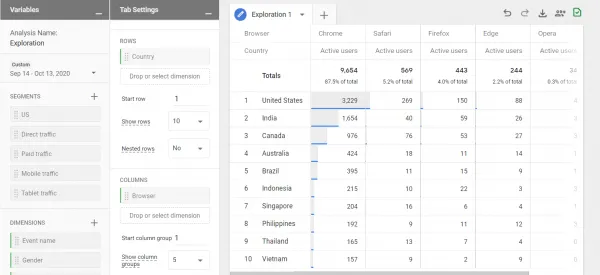
Custom Funnels allow you to visualize progress and abandonment through a flow of up to 10 steps.
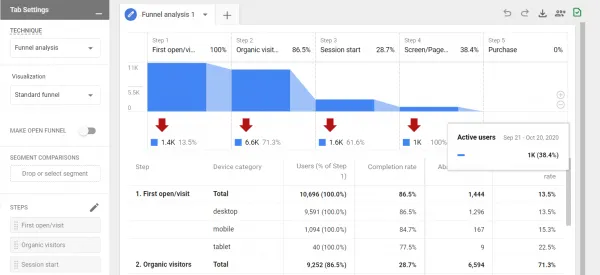
Pathing enables you to explore how users navigate your site or app through a sequence of pages or events.
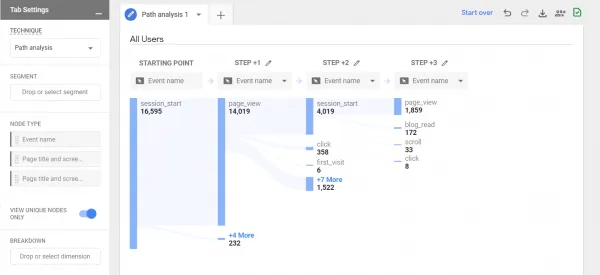
Analysis Hub also provides Segment overlap, Cohort analysis, User lifetime, and User explorer analysis techniques.
Beyond the reporting and analysis capabilities available within the interface, GA4 also provides you with access to your raw data in BigQuery. This has previously been an Analytics 360 feature, but GA4 brings BigQuery export to everyone. With BigQuery, you will have the ability to run more complex queries and models over your GA data, as well as join it with data from other sources.
We hope this article has inspired you to get on board with GA4 if you haven’t already. Check out our blog post on How to Setup Google Analytics 4 with GTM for tips on getting started.
If you have any questions or need advice, leave us a comment or send us a message.

